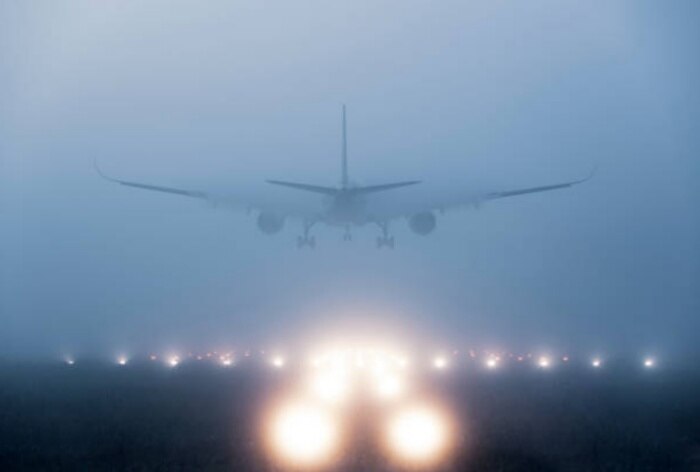Dense fog affects IndiGo flight operations in Delhi, causing 22 trains to be delayed
New Delhi: Safdarjung, the city’s primary meteorological station, recorded the lowest temperature of 9.4 degrees Celsius on Friday morning, 2.5 degrees Celsius below average, as a cold wave continued to engulf Delhi and the National Capital Region.

Data from the India Meteorological Department shows that on Thursday, the city had its lowest midday temperature of the year.
Today at 8:30 am, the national capital’s Ridge station recorded a minimum temperature of 9.1 degrees Celsius, which is 1.4 degrees below the average. The lowest temperature ever recorded in Palam was 10.0 degrees Celsius, which is 3 degrees Celsius below average. Ayanagar had the lowest temperature of 9.8 degrees Celsius, which was 2.8 degrees Celsius below average.
According to IMD, Delhi and the National Capital Region may expect to experience a cold wave for the next two to three days.
When the lowest temperature falls below 10 degrees Celsius and the highest temperature is at least 4.5 degrees below average, a meteorological “cold day” is proclaimed.
In several areas of Delhi, there was a thick fog, the IMD said around 5:30 a.m. today.
IMD released a statement stating that very dense fog conditions were seen in a few isolated areas across Punjab, Delhi, West Uttar Pradesh, East Madhya Pradesh, and Haryana; there was also dense fog in certain pockets over Rajasthan, East Uttar Pradesh, Bihar, Jammu, and West Madhya Pradesh.
Bad weather is affecting flight operations to and from Jaipur, Patna, and Amritsar, according to IndiGo.
Due to weather, the following flights were canceled: IXC PNQ 681/STD 2215 hours, IXC JAI 7413/STD 2100 hours, IXC AMD 6395/STD 1915 hours, and IXC CCU 6041/STD 2045 hours.
Fog caused many trains at Delhi’s Hazrat Nizamuddin railway station to be delayed.
According to a statement from Indian Railways, there are around 22 trains arriving in the city from different areas of the nation that are running late because of the fog in the northern region.
The August Kranti Rajdhani (12953) Express, Bangalore-Nizamuddin Rajdhani Express (22691), and Jammutawi-New Delhi Rajdhani (12426) are among the trains that Indian Railways reports would arrive late in Delhi on January 5, 2024. The Dibrugarh-New Delhi Rajdhani (20503) arrived one hour and thirty minutes late, while the Bhubaneswar-New Delhi Rajdhani (22823) was four hours behind schedule. The delays are still present. The Ambedkarnagar-Katra Express (12919) is two and a half hours late, while the Puri-New Delhi Puroshottam Express (132801) and Saharsa-New Delhi Vaishali Express (12553) are all four hours late. Among the trains that are running late are the Muzaffarpur-Anand Vihar (12557), VSG-Nizamuddin (12779), and Chennai-New Delhi GT (12615).
“Visibility recorded (at 0530 hours IST of today) (in meters): Haryana: Ambala- 25; West Uttar Pradesh: Bareilly-25; East Madhya Pradesh: Sagar-25; Punjab: Amritsar-50, Patiala-200; Delhi: Palam-50; West Rajasthan: Churu-50, Bikaner-200; East Rajasthan: Jaipur, Ajmer, Kota, Udaipur-50 each; West Madhya Pradesh: Bahraich, Gorakhpur- 50 each; Bihar: Gaya, Purnea-50 each.” IMD made a post on X.
According to the IMD, temperatures in some areas of Punjab, Haryana, Uttar Pradesh, and Rajasthan are expected to remain frigid to very cold for the next two days before dropping down.
Additionally, the IMD predicted that over certain areas of the plains in Northwest and East India, thick to extremely dense fog is anticipated to persist for the next two days before progressively decreasing.
The Met Department predicted that many areas of Central and East India will likely see an increase in minimum temperatures of two to three degrees during the following three days, with no more notable changes.
The IMD has released a public health advice warning against the potential negative effects of the cold wave and severe fog on respiratory health. “Dense fog contains particulate matter and other pollutants and in case exposed it gets lodged in the lungs, clogging them and decreasing their functional capacity which increases episodes of wheezing, coughing and shortness of breath,” according to the IMD.
At 11 a.m. today, the Air Quality Index (AQI) was 349.
The Central Pollution Control Board (CPCB) records show that at 4 p.m. on Thursday, the 24-hour average Air Quality Index (AQI) was 377, falling into the “very poor” category.
The IMD issued a warning about air pollution’s tendency to irritate the eye’s membranes, which may lead to numerous diseases and cause swelling or redness in the affected eye.







